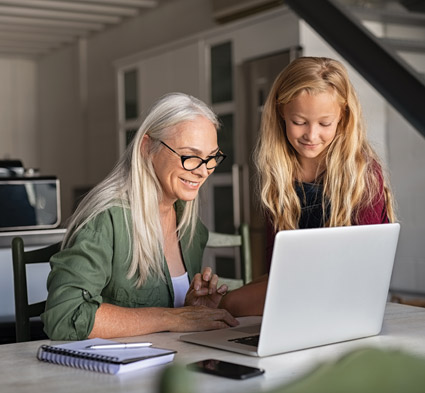
In-person, hybrid, full remote – the types of schooling preschoolers to high school seniors experienced in 2020 – and now in 2021 – has been a shifting landscape thanks to COVID-19.
If like so many other aunts, uncles and grandparents, you’ve been asked to shoulder – or occasionally fill in with – remote schooling duties for family members since schools shut down last March, we hear your challenges.
Prime recently reached out to several individuals on the front lines – grandparents handling remote schooling duties as well as the Youth Development director of the Westfield YMCA – for tips and advice to help you keep school-age children learning at home.
If you’ve just been tapped to temporarily help out with remote schooling, or you just do this occasionally, our experts said it’s important to get familiar with the hardware and software the kids are using.
“Go look up Google classroom and get some background [on the program], “said Michelle Anamisis, Youth Development director for the Westfield YMCA. She added that finding someone who could “give you a tutorial or quick overview on how to use it would be very helpful.”
For the tech savvy, Anamisis said Google Classroom training links are available online. One useful link to a tutorial on how to use Google Classrooms for parents and grandparents that Prime located is available at https://www.youtube.com/watch?v=IgS-hoSIjnw
Anamisis also said grandparents should not feel intimidated by having to play catch up on the tech used in remote learning. “I have kids in school and had to get a crash course [in Google Classroom]; when I finished college there was no such thing,” she shared.
Christine Tetreault, a lawyer in private practice who is also helping her four grandchildren with remote learning, said she also had to learn to navigate the Chromebooks they were using. Though Tetreault said she was pretty tech savvy, “learning Chromebook when you are used to a
Windows environment” took adjustment, especially when the schools shifted abruptly to remote learning last spring.
Prime found a tutorial on getting started with Chromebook on YouTube: https://www.youtube.com/watch/yKXXj_dguz0.
More Chromebook help is available online at the Chromebook Help Center at: www.support.google.com/chromebook.
Tetreault also said it is important to get the names of, and become familiar with, any of the additional programs, such as Zoom, that the children may be using for their classroom instruction. “Basically I had to learn all of those things to at least be able to help the kids,” Tetreault said. “I can count four to five other programs they use within the school day.”
Anamisis, who oversees the remote learning center at the Westfield Y, said teachers provide schedules and information on what is expected from their students each day. Whoever is overseeing the student’s work should be familiar with that schedule. At the Y, they have binders that contain each child’s schedule and assignments, she added.
Tetreault said it is also important to know how to contact the child’s teacher, either by email, text or messaging. ”Make sure you are communicating with them,” Tetreault said, indicating that if there has been
an issue with the WiFi, or other connectivity problems it’s important the teachers know, as an online absence is the same as an in-person absence, and can go on the child’s permanent record.
Michelle Labonte, who assists her kindergarten-age grandchild with online learning, said it’s also important to reinforce the lessons that happen
online. “My best advice to parents, grandparents, anyone having to home school a child is to get them to do more work than is being done on Zoom. Practice on paper, not just on an iPad or Chromebook. Move them forward, don’t just leave them with a tablet in their hand.”
Tetreault agreed that sometimes offline learning is important to get concept clarity for a remote learner. “With my second grader the teacher will [use] a whiteboard so they can do math problems on [it] and hold it up
to the screen,” Tetreault said, noting sometimes her student doesn’t get it. “I whip out a pad and say ‘let’s try to do that again’ and draw a picture or a number line. After awhile they just get screen blind,” she added.
Nicole Brown-Collins, an elementary school teacher now working in Florida, suggested checking out online sites such as Khan Academy (https://www.khanacademy.org/) and Mathways (https://www.mathway.com/) as places grandparents and their “students” can turn for extra help with concepts.
Tetreault said that her second-grader needs to be “by my side” to stay focused and to understand what’s going on in the classroom. “The older ones just come to me for assistance when needed,” she said.
Labonte agreed, saying her kindergartener “moves around a lot, thinking she can write on other things instead of paying attention to her teacher most of the time.” She spends a lot of her time refocusing and redirecting her “student.”
Tetreault noted the same focus issue happens even with the older students, who often come looking for a snack, or go on their phones, when they are supposed to be in class.
“I spend a lot of time redirecting,” Tetreault also said.
Anamisis and Tetreault both agreed that building breaks into the remote school day is essential for helping students maintain focus. “Some of the teachers do have built-in breaks especially for younger kids. The middle school and high school there are not so many, they go straight through,” Anamisis said.
Tetreault said it is important to use that break time to get the kids to do some physical activity, such as a walk or bike ride if weather permits.
Suzanne Wayner, who is working with her kindergarten and second grade grandchildren for remote learning, said the thing she has found most crucial to success in this new schooling model, is patience.